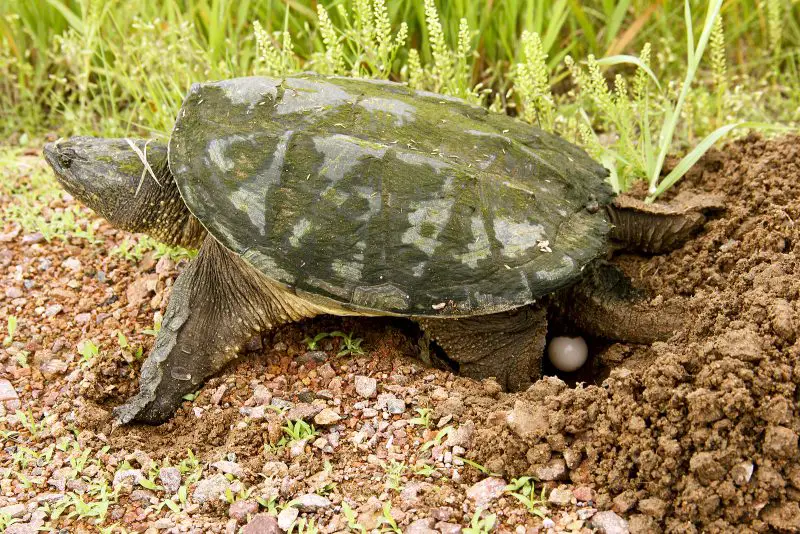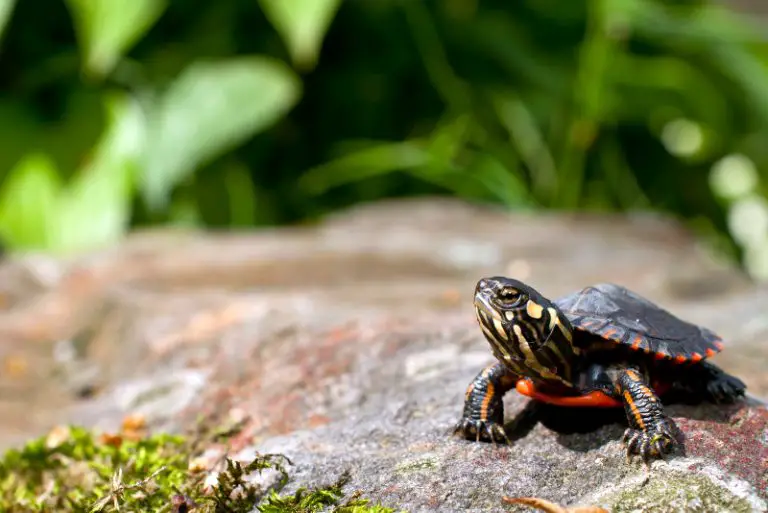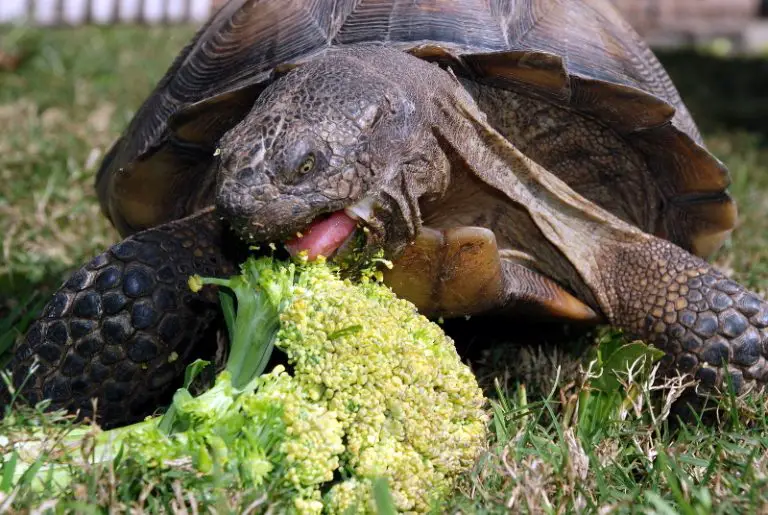Gestation Period For Snapping Turtles, Dealing With Eggs & More

Snapping turtles are the biggest freshwater turtles found in the United States and across North America. Although you will not often see them laying eggs, they can lay dozens at a time. Sometimes they spend large amounts of time finding the perfect spot to conceal their eggs.

If you have ever wondered about the gestation of snapping turtle eggs and how they are hatched, you’ve come to the right place. Keep reading for more snapping turtle eggs facts.
Contents
Table of Contents
What Are Snapping Turtles?
Snapping turtles, or Chelydra serpentina, are one of the world’s largest species of freshwater turtles, and they come with quite a bite.
They aren’t able to hide within their shells to protect themselves like other turtles can, so they will bite in defense if they feel threatened.
What Do They Look Like?
Snapping turtles can grow to be quite large, up to 60 pounds, and they can live up to 40 years. Their bodies are quite distinctive from other turtle species because they have a large head and long neck. Their head and neck will often be covered in warty growths called tubercles.

They have a deep green upper shell. That shell has three ridges, or keels, with a smaller bottom shell that doesn’t cover the turtle all the way.
They have 4-5 long claws on each webbed foot, and their tail is covered in protective bony plates.
Where Do They Live?
They are found in a wide range of freshwater habitats ranging from eastern Canada, down the eastern and central United States, all the way through Mexico and Central America.
Even though snapping turtles can be found in cold areas like Canada and the northeast United States, they much prefer to live where it is warm.
Because they don’t like cold weather, they will generally hibernate from October until March if they live in areas where the weather becomes too cold. When they hibernate, they like to hide in the bottom of lakes, banks, and even inside muskrat holes.
Although they can be found hiding in the edges of deep lakes and rivers, they prefer shallow water with stagnant or slow water. They also love to live in areas with plenty of vegetation and mud for them to hide in.
During the time of year when snapping turtles are most active, they are mainly nocturnal, so it is rare that you will spot one out during the day.
Unlike other turtles found in similar habitats, however, snapping turtles do not like to bask on land and prefer to stay hidden. Instead, they will bask in the sun at the surface of the water with just their head and shell out of the water.
What Do They Eat?
They will eat almost anything they can catch, including fish, snakes, insects, and other small animals. They will also feast on the carcasses of dead animals and plants.
Snapping turtles like to hide under vegetation and in the mud at the bottom of the water column. This is where they are most comfortable, and they use the location to their advantage to hunt for prey.
They do most of their hunting at night where they will hide in the mud and vegetation waiting to ambush their prey.
Are They Dangerous To You?
Although they certainly have a fearsome bite, snapping turtles aren’t to be feared unless you give them a reason to think you’re a threat.
Their total bite force equals about 209N while a human’s bite can pack up to 1,300N. Still, if they do bite you, they are strong enough to break bone, so they shouldn’t be handled.
Unfortunately, most adult snapping turtles are killed by humans out of fear. They may also be killed unintentionally by cars when trying to cross the road.
Snapping Turtles VS Alligator Snapping Turtles
Common snapping turtles and alligator snapping turtles are very similar. The easiest way to tell them apart is in their physical characteristics.
Alligator snapping turtles (pictured above) look more ancient, with large spikes on their shells versus the common snapping turtles whose shells are smooth.
Alligator snappers are also much larger than the common snapping turtle, with males reaching weights of up to 220 pounds. Females are much smaller, only reaching about 50 pounds.
However, the key difference between the two snapping species is their rarity. Common snapping turtles are, well, common. In comparison, alligator snapping turtles are quite rare and are listed as threatened and endangered in most states where they live.
Another way in which they vary is where they live. While common snapping turtles can be found in colder northern areas, alligator snapping turtles don’t live above the southeastern United States.
What Is The Gestation Period For Snapping Turtles?
Snapping turtles prefer to mate between April and November when it is warmest and they are most active.
The gestation period for snapping turtles can vary because the female is capable of holding sperm within her until she has found an area that she finds suitable for hatching. She can even hold sperm for several years until she is ready to lay her eggs.
So, what is the average gestation period for snapping turtles? In general, the gestation period lasts about 90 days.
When Do Snapping Turtles Lay Eggs?
The time in which snapping turtles choose to mate and lay eggs also varies depending on the climate, but the most common time to lay eggs is the middle of June to July.
If eggs are laid during this period, they are likely to hatch between August and November.
How Do Snapping Turtles Lay Eggs?
When snapping turtles are ready to mate, they will do so in the water. The male will swim over the top of the female and clasp her with his four feet so that they are positioned tail to tail.
Once they are done mating, the female will crawl out of the water in search of a suitable nesting site.
Unfortunately, this is the time in which most snapping turtles are hit and killed by cars. Many females will try to cross the road to find their preferred nesting site, and not all make it across safely.
Watch this video: Gestation Period For Snapping Turtles, Dealing With Eggs & More
Where Do Snapping Turtles Lay Eggs?
If you have ever seen a snapping turtle laying eggs, you’ll know their favorite place to lay eggs are areas of loose soil that is easy to dig up. Some suitable places include fields, banks of sand and dirt, or the edges of ponds.
Once she has found a good spot, she’ll dig a 4-8 inch hole that resembles a bowl-shape. She may dig several holes before she chooses the right one to lay her eggs in. Snapping turtles usually like to lay their eggs where it’s sunny.
Once she has laid the eggs, she will cover the nest back over with the dug-out dirt and then leaves them to return to the water.
Unfortunately for unborn snapping turtles, they are in much danger of being eaten. Approximately 90% of all snapping turtle nests are hunted and destroyed by predators such as skunks, foxes, minks, and raccoons.
How Many Eggs Do Snapping Turtles Lay?
When a snapping turtle is ready to lay eggs, she will release about 20-40 eggs into her chosen nest. Although that is the common range for eggs laid, snapping turtles can lay as few as 10 eggs or as many as 80 eggs at one time.
These eggs are quite small, only about the size of a ping-pong ball and they will be an off-white color.
What Is The Incubation Period Of Snapping Turtle Eggs?
The exact incubation period for snapping turtle eggs depends on the temperature of the surrounding environment. In general, however, eggs will begin to hatch after about 80-90 days. In areas where the weather is unsuitable, eggs can take up to 6 months to begin to hatch.
When snapping turtles are born in northern areas when it is cold, the hatchlings may stay in the nest until the winter is over. This protects them from the harsh temperatures and helps them better survive until the coming spring.
Another interesting thing about snapping turtle eggs and incubation is the relationship that the surrounding temperature has on the resulting sex of the turtles. This is a phenomenon that is common in many turtles, and snapping turtles are no different.
When eggs are laid in environments that are under 70oF, or above 75oF, more females are hatched than males. If the temperature is between 70oF and 75oF, more males are likely to be produced.
How Do Snapping Turtle Eggs Hatch?
Snapping turtle hatchlings break free from their eggs similarly to how other turtles break out of their eggs.
Hatchlings contain an egg tooth at the tip of their beak to help them break open their shell.
Unlike some eggs, snapping turtle eggs are a leathery texture which can make it more difficult to get out of the shell. The egg tooth helps to break through the surface of the shell.
After they hatch and break out of their eggs, they head straight for the water where they’re safest.
Just like when they’re in their eggs, hatchling snapping turtles are at a high risk of predation. They don’t want to be exposed on land for long, so they move quickly to the water.
Unfortunately for these young turtles, they are not safe in the water, either, although they have a better chance of survival. At birth, young snapping turtles are only an inch long, and their shells are still very soft.
When entering the water, the snapping turtles are now at risk of being eaten by large fish such as bass, and even adult snapping turtles.
So now you have baby snapping turtles, you can click here to read what they eat.
Conclusion
Although they can live in colder areas, snapping turtles are happier and more active during the warmer months. It makes sense then that they prefer to lay their eggs between June and July.
Although the timeframes vary, both the gestation period and incubation period lasts for about 90 days.
If you’ve ever wondered about the fascinating process of snapping turtle reproduction, now you know.
Click here to find out if turtles eat frogs or here to see if they should eat brocoli. You can find all our turtle guides here. Want to know how big snapping turtles grow? Click here.



![How Big Do Painted Turtles Get? [Must Read]](https://allourcreatures.com/wp-content/uploads/2021/11/painted-turtle-log-768x513.jpg)

![Do Turtles Eat Frogs? [Complete Answer]](https://allourcreatures.com/wp-content/uploads/2021/11/frogs-768x512.jpg)

